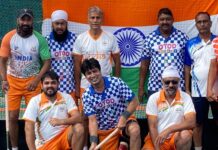[vc_row][vc_column][vc_column_text]
MYTH-BUSTING Indian Cricket Behind the Headlines
MYTH-BUSTING
Indian Cricket Behind the Headlines
By Gulu Ezekiel
Price; Rs 295
Rupa Publications
There is a myth that Cricket in India gained popularity after it won the 1983 World Cup as the victory was directly beamed to the drawing rooms of millions of people back home and they felt elated and proud watching Kapil Dev and his men lording at Lords, venue of many a humiliating defeats of their predecessor.
This is not correct. Cricket has been immensely popular sport in the Sub-continent since 1930s mostly patronised by the rajas and nawabs and too some extent by the British.
After Independence, hockey was declared national game and it did bring laurels to the country with three Olympic-gold (1948, 52 and 56). But surprisingly, Cricket held its own among the masses despite team’s dismal and often pathetic showing.
It was indeed ironic to see more books and write-ups on Indian Cricket players and the team after every disastrous performance while very few if any books at that time came out glorifying Hockey or Football. We have books on and about the former cricketers who wrote about their exploits in domestic circuit and talked emotionally about the defeats they suffered at international level.
Intriguingly, every defeat against West Indies, England, Australia and even Pakistan brought more crowd to the stadiums. Instead of thinning support base craze for cricket kept widening.
Every defeat was laced with some myths and few and far victories in that era became a sort of folklore. “Cricket around the World is built on myths and Indian cricket is no
different. These myths have been repeated ad nauseam over the years till they have come to be accepted as fact” opines Gulu Ezekiel.
To demolish these myths and de-glamourise some of the cricketing folklores, Gulu Ezekiel set on a tough, unpopular and arduous journey and the result is the 232-page book – MYTH-BUSTING Indian Cricket Behind The Headlines.
Gulu is veteran sports journalist but he Lives cricket. This is his 14th book and second which I am reviewing.
Reviewing a book written by a friend is very tough job and on top of it if it is specifically related to cricket because 90 percent chances are that writer and reviewer know each other.
I know Gulu for over three decades and having lavishly praised his previous co-authored book Speed Merchant I was apprehensive about this one. But forward written by Anil Kumble made job easier
Kumble sums up the book nicely: “Gulu’s attempt to demystify some of these myths of Indian cricket is unique and commendable. His desire to sift fact from fiction and the painstaking research that has clearly gone into the process is evident. Underneath the facts, stories and anecdotes, lies the desire to get rid of some of these existing myths and
rumours, in order to purify this beautiful game.”
Myth Busting has several startling facts which so far have been camouflaged and one of them is about Ranji.
Ranji Trophy is now a part of Indian cricket’s folklore. The hallowed tournament named after Shri Sir Ranjitsinhji Vibhaji, Maharaja Jamsahab of Nawanagar aka Ranji has showcased domestic talent which took the sport in the country to its pinnacle .
In a chapter “Ranji, the legend and the myth” the author quotes first secretary of BCCI Anthony de Mello “Ranji did absolutely nothing for Indian Sports and Sportsmen”.
According to de Mello, “We approached Ranji with a request that Duleep (Sinhji) be encouraged to bring his cricket talents to the aid of India. To all our requests for aid, encouragement and advice, Ranji gave but one answer; ‘Duleep and I are English cricketers’.”
To this Gulu writes ‘India’s embracing of the legend and the man, even though he played his major cricket in England and had a hardened disdain for all things connected to Indian cricket, is not unique”
There are several myths which have been accepted because they are harmless and amusing. One of them being an imaginary quoteattributed to Australian captain “mate you have just dropped the world cup” after his rival dropped a catch in that tournament.
In India, Salim Durrani, the handsome all-rounder, was nicknamed the Sixer man who hit Six whenever the crowd demanded or asked for it. This myth has been punctured by the author pointing out that thoughthe tall Pathan was a rare talent he hit only 15 sixes in 50 innings.
Most of the cricket fans lament that because of a strike in BBC they could not watch Kapil Dev’s historic 175 against Zimbabwe in 1983 World Cup.
Gulu effectively demolishes this myth proving that two other matches on that day Involving England/Pakistan and Australia/west Indies had live telecast. If there was a strike, how come these two matches were shown.
The author has an answer, because India/Zimbabwe match was not a priority event for the BBC and both the teams were considered rank outsiders. After India’s stunning performance this canard of strike was spread which became a myth and later accepted as a fact.
There is a detailed chapter on the Tied Test titled “Chepauk’s Many Myths. It is about the test match between India and Australia in 1986 played in then Madras.
The author details the test proceedings with quotes from the players, media persons and umpires which are contradictory. He comes to the conclusion the tied test was after all was not that tied. But as it has been officially recoganised as tied test number two he ends it with a quote from opener K. Srikkanth “Hay guys ,forget the win, we have become part of history”.
The author also challenges another myth that Bishan Bedi virtually surrendered the Test against West Indies by declaring when the team lost five wickets for 97 at Sabina Park Jamaica. He shows that there was nothing the skipper could do as other five players were injured and unfit to bat and the story that Indian captain declared in protest is false.
The book is full of reality checks. It also contradicts Farokh Engineer’s assertion of scoring fastest test century from just 47 balls. The dashing wicket keeper batsman has also claimed that he hit three boundaries off the first three balls he faced on his debut but that claim has also been proved wrong.
“Engineer is not the first and certainly not the last among many Famous sportspersons to embellish his own deeds with colourful stories which have entered cricket folklore and are accepted as gospel truth” (Page198).
The book also covers Engineer’s sullen reaction after Abid Ali hit the winning run in that historic Oval test in 1971. The wicketkeeper was on the other end on 28. He had scored 59 in the first innings “Abid rushed out, got a top edge and voila, we were home and Abid was a hero, never mind how he got the run’.
Except that it was not a top edge, it was a square cut to the boundary and the video footage is freely available (page 206).
There are several other intriguing myths perpetuated for decades like “Mankading” which have been de-mystified by Gulu. The book also vividly recalls Indian cricket’s Grand Slam moments from June 1983 to March 1985. Details Kapil Dev’s era Before and After. Younger
generations aggressiveness epitomized by Virat Kohli etc.
As Anil Kumble writes, “The true hero of this book is Gulu” and he is absolutely correct.
Myth-Busting is not any other cricket book it is well documented thesis which is very absorbing and funny, and some time hilarious, and as it proclaims is a cricket connoisseur’s delight.
To sum it up MYTH-BUSTING is simply unputdownable.
[/vc_column_text][/vc_column][/vc_row]
Disclaimer: We do undertake rigorous checks on content provided by contributors before publishing the same. If you come across some factual errors, kindly bring this into our notice and we shall review your objection and claim as per our policy and display correction credits and corrections on the article itself.
The opinion expressed in the article is of the writer. Writer is a freelance journalist/journalist based in Delhi































